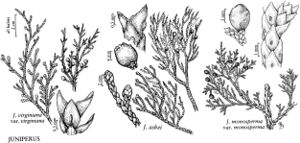Juniperus virginiana var. virginiana
Trees to 30 m; crown narrowly erect (in young, fast-growing trees) to conic or occasionally round. Bark reddish-brown. Branches erect, spreading, or pendulous. Scalelike leaves acute at apex. Pollen cones 3–4 mm. Seed-cones globose to ovoid, 4–6 (–7) mm. Seeds 2–4 mm. 2n = 22, 33.
Habitat: Upland to low woods, old fields, glades, fencerows, and river swamps
Elevation: 0–1400 m
Distribution
Ont., Que., Ala., Ark., Conn., Del., D.C., Fla., Ga., Ill., Ind., Iowa, Kans., Ky., La., Maine, Md., Mass., Mich., Minn., Miss., Mo., Nebr., N.H., N.J., N.Y., N.C., Ohio, Okla., Pa., R.I., S.C., S.Dak., Tenn., Tex., Vt., Va., W.Va., Wis.
Discussion
Eastern redcedar hybridizes with the related species Juniperus horizontalis (M. Palma-Otal et al. 1983) and J. scopulorum (C. W. Comer et al. 1982). Reported hybridization with J. ashei has been refuted in subsequent studies (R. P. Adams 1977).
The wood of Juniperus virginiana is used for production of eastern redcedarwood oil, fenceposts, and cedar chests.
Selected References
None.
Lower Taxa
"overlapping" is not a number."thick" is not a number.
